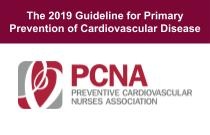Cardio-Oncology: Preventing & Treating Cardiovascular Complications Associated with Cancer Treatment
Dr. Tochi Okwuosa
Dr. Tochi Okwuosa will define the common types of cancer treatments that may damage the heart and blood vessels and describe CVD risk factors in cancer survivors and how to prevent and manage them.
The 2019 Guideline for Primary Prevention of Cardiovascular Disease
Cheryl Dennison-Himmelfarb
Guideline writing panel member and former PCNA President, Dr. Cheryl Dennison-Himmelfarb provides a timely discussion of the 2019 Guideline for Primary Prevention of CVD with a focus on the role of nurses in applying the Guidelines to clinical practice. This Guideline integrates recent cholesterol, hypertension, and physical act....
Reducing Health Disparities through PAD Awareness
Abbie Schrader
Join Abbie Schrader, ARNP, as she discusses the epidemiology of peripheral arterial disease (PAD) and its comorbidities, including the disparities in diagnosis, treatment, and outcomes. Abbie also reviews guideline-based strategies and other solutions for PAD diagnosis and management including non-pharmacologic and pharmacologi....
Aortic Stenosis: Healthy vs. Unhealth Aortic Valve
Chloe D. Villavaso
The first of four peer-to-peer videos that aim to increase awareness of valvular heart disease and the important role that nurses play in early identification, access to prompt treatment and prevention of deleterious outcomes. The first video in this series is presented by Chloe Villavaso, a cardiac clinical nurse specialist and....
L'importance de l'évaluation
Rebecca C. Threatt
L'évaluation physique est un élément essentiel pour fournir des soins de qualité à tous les patients. Il est important de connaître les antécédents médicaux du patient (ce qui est normal et ce qui ne l'est pas). Cela aidera à prendre connaissance des principales préoccupations, à savoir ce qui ne va pas, à localiser des douleurs....
Community Health Worker
Tciurban Health (The Challenge Initiative’s Knowledge Management Team at Johns Hopkins Center for Communication Programs)
Community health workers (CHWs) are an important cadre of workers in a health system. Personal contact with such a well-informed community member can help alleviate women’s and men’s fears about family planning, present contraceptive method options for spacing or limiting births, and facilitate access to family planning and othe....
Venous Thromboembolism (VTE) & Management of Anticoagulation
Mr WCEA Administrator
This lecture will cover VTE’s from clinical presentation until initiation of treatment, duration of therapy and the required patient follow up.
An Approach to Thyroid Disease
Dr Greg Yudelowitz
Approach to interpretation of thyroid function tests/ diagnosis and treatment of common thyroid disorders
Antibiotic Awareness
Dr. David G. Allison, Dr. Christine Furber, Dr. Carol Hindley, Dr. Roger Harrison
This course covers antibiotic awareness
Professionalism, Integrity and Discipline: Session 2
Dr. Kalaba Chilufya and Dr. Chibasa Muchenelah
Topics covered: Health Records 101 Medical clerkship made easy Signing off on documents and prescriptions Alteration of Health Records Certificates and reports Medical record keeping Takeaways.
Community Pharmacy: Overview
Suraj Varia
This session provides an overview of community pharmacy by describing premises layout, team roles, services offered and the contract under which community pharmacies operate. It is part of the Pharmacy in Primary Care e-learning programme to support pre-registration community pharmacists.
Dermatology - Role of the Pharmacist
Siun Tobin
This module focuses on common dermatological presentations — acne, eczema and psoriasis — in pharmacy.
COVID-19 Vaccine: Debunking Myths
Prof Wesley Too
This course is about debunking myths about the covid-19 vaccine
PACK Global COVID-19: Clinical management
The UCT Lung Institute and University of Cape Town
This course is designed for front-line staff who are required to manage COVID-19.
Cytomegalovirus (CMV) in Neonates
Dr. Juli Reynolds, PhD
This course is about Cytomegalovirus (CMV) in Neonates
Obesity During Pregnancy
Dr. Juli Reynolds, PhD
This course has been developed for Midwifes, Anti-natal and Post-natal nurses and covers the risk factors of obesity during pregnancy, birth and postpartum. The course covers the risk factors and management of obesity during pregnancy.
Delirium & Managing Challenging Behaviours
Sarah Potter and Anne Duncan
0.25 Hours
This session looks at delirium as a common yet complex and serious syndrome, the significant incidence of delirium in Australian hospitals and the key aspects for optimal identification and management of the condition. It also overviews strategies for the management of emotional and behavioural disturbances as a significant....
Bioethics and Ethics in Medical Research
Elizabeth Anne Bukusi, MBChB, M.Med (ObGyn), MPH, PhD, PGD, Professor S. Molyneux and John Munene M
Outline: Introduction Medical Ethics Research Ethics Basic Principles of Clinical Ethics
CONSERVATION, PRÉPARATION ET ADMINISTRATION DES VACCINS COVID-19
Dr. Maureen Akolo, BScN, MPH, Ph.D
Ce cours porte sur le stockage, la préparation et l'administration des vaccins
Critical Thinking Skills
Rebecca Threatt, DNP, RN, CHSE
This module is designed to work through on your own or in a group. If you are working through this on your own, do not skip the discussion, talk through these sides on your own, make sure to use your higher level of thinking! the quiz will really make you think! Once your course is completed, you can ask your matron for the answ....
Hypertensive Disorders in Pregnancy
Dr Nelisiwe Lembethe
This webinar will discuss a practical approach in identification and management of hypertensive disorders in pregnancy.
Administration of Drugs by Subcutaneous Injection
Gerry McKay
This session describes the use of subcutaneous (SC) injection as a route of drug delivery. It covers the reasons why it is used, the common types of drugs that can be given this way, practical aspects of giving a subcutaneous injection and adverse effects that might be encountered.






















